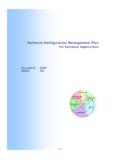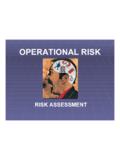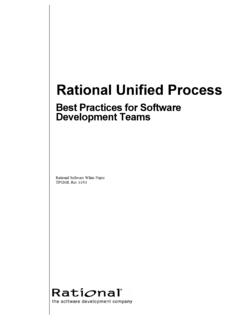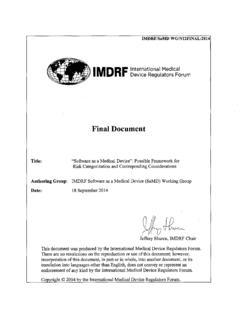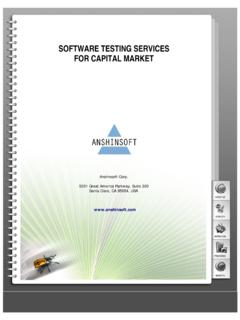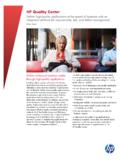Transcription of Glossary of Software Engineering Terms
1 Glossary of Software Engineering Terms Document ID: SEGLOSSARY Version: PlanningRequirements DefinitionDesignDevelopmentIntegration & TestInstallation & Acceptance 1 / 31 Glossary of Software Engineering Terms SEGLOSSARY Copyright 2000-2005 Digital Publications LLC. All Rights Reserved. 2 / 31 Glossary of Software Engineering Terms SEGLOSSARY INDEX OF Terms ACCEPTANCE 9 ACCEPTANCE 9 ACCEPTANCE 9 9 9 9 9 9 9 9 10 10 10 10 10 BATCH 10 BUSINESS 10 BUSINESS PROCESS 10 BUSINESS PROCESS 10 BUSINESS 10 11 CODE 11 11 COMPUTER 11 COMPUTER-AIDED Software Engineering (CASE).. 11 CONFIGURATION 11 11 CONTEXT 11 CONTROL (RISK).. 11 11 CRITICAL SUCCESS FACTORS (CSFS) .. 11 CUSTOMER 12 12 DATA 12 DATA 12 3 / 31 Glossary of Software Engineering Terms SEGLOSSARY DATA 12 DATA FLOW 12 DATA 12 12 DATABASE 12 DATABASE 12 DATABASE MANAGEMENT SYSTEM (DBMS).
2 13 13 13 DESIGN 13 DESIGN 13 DESIGN 13 DEVELOPER 13 DEVELOPMENT 13 13 14 END-USER 14 14 ENTITY-RELATIONSHIP 14 14 EXTERNAL 14 EXTERNAL INTERFACE 14 FEASIBILITY 14 14 14 FOREIGN 14 15 FORMAL ITERATION 15 FUNCTIONAL 15 FUNCTIONAL 15 FUNCTIONAL 15 FUNCTION POINT 15 15 15 15 HIERARCHICAL 15 HYPERTEXT MARKUP LANGUAGE (HTML) .. 15 IMPLEMENTATION 16 IMPLEMENTATION 16 INCREMENTAL 16 16 INFORMAL ITERATION 16 16 INFORMATION 16 16 INITIAL DATA 16 4 / 31 Glossary of Software Engineering Terms SEGLOSSARY INITIAL 17 INNER 17 INSERTION 17 17 IN- STAGE ASSESSMENT 17 INSTALLATION AND ACCEPTANCE 17 INTEGRATION AND TEST 17 17 17 17 INTERFACE 17 17 ITERATIVE DEVELOPMENT 18 18 JOINT APPLICATION DESIGN (JAD).
3 18 KEY 18 KEY PROCESS 18 KICKOFF 18 KILOBYTE (KB).. 18 KNOWLEDGE 18 18 LOGICAL DESIGN DOCUMENT (LDD) .. 18 19 MASTER 19 MEGABYTE (MB) .. 19 MEGAHERTZ (MHZ) .. 19 19 19 19 19 19 19 MODULE 19 19 20 OBJECT 20 OFFICE AUTOMATION SYSTEM (OAS) .. 20 ONLINE ANALYTICAL PROCESSING (OLAP) .. 20 ONLINE TRANSACTION PROCESSING (OLTP) .. 20 OPEN DATABASE CONNECTIVITY (ODBC) .. 20 OPERATING 20 OPERATIONAL DATA 20 OPERATIONAL TRANSACTION 20 20 21 OUTER 21 5 / 31 Glossary of Software Engineering Terms SEGLOSSARY OUTER 21 21 PEER 21 21 PLANNING 21 PRIMARY DEVELOPER REPRESENTATIVE (PDR) .. 21 PRIMARY END-USER REPRESENTATIVE (PER) .. 21 PRIMARY 22 22 22 22 PRODUCTION INITIATION PLAN (PIP) .. 22 PROGRAMMING 22 22 PROJECT 22 PROJECT 22 22 22 23 QUALITY ASSURANCE 23 23 RAPID 23 RELATIONAL DATABASE MANAGEMENT SYSTEM (RDBMS).
4 23 23 REFERENTIAL 23 REGRESSION 23 RELATIONAL DATA 23 23 RELEASE 23 24 REQUIREMENTS 24 REQUIREMENTS 24 REQUIREMENTS 24 24 REVERSE 24 24 24 25 RISK 25 25 25 25 SIMULTANEOUS 25 25 Software CONFIGURATION 25 Software DESIGN DOCUMENT (SDD).. 25 6 / 31 Glossary of Software Engineering Terms SEGLOSSARY Software DEVELOPMENT LIFECYCLE (SDLC) .. 25 Software 25 Software PROJECT MANAGEMENT 26 Software QUALITY ASSURANCE (SQA).. 26 Software REQUIREMENTS DOCUMENT (SRD) .. 26 SOURCE 26 26 SPIRAL DEVELOPMENT 26 26 STAGE EXIT 26 26 27 STANDARD OPERATING PROCEDURES (SOPS) .. 27 STRUCTURED 27 STRUCTURED QUERY LANGUAGE (SQL) .. 27 SUBJECT MATTER EXPERT (SME) .. 27 27 SUPPORT 27 SUPPORT DATA 27 27 SYSTEM DESIGN 27 SYSTEM 28 SYSTEM 28 SYSTEM 28 SYSTEMS 28 SYSTEMS 28 28 28 TECHNICAL 28 TECHNICAL 28 28 29 TEST 29 TESTING 29 TEST 29 TEST 29 TEST RESULTS 29 29 29 29 29 TRANSACTION 30 30 UNIT 30 30 USE 30 7 / 31 Glossary of Software Engineering Terms SEGLOSSARY 30 USER 30 USER 30 30 30 VERIFICATION AND VALIDATION PLAN (VVP).
5 30 VIRTUAL 31 31 WATERFALL DEVELOPMENT 31 31 WORK BREAKDOWN STRUCTURE (WBS) .. 31 WORK 31 8 / 31 Glossary of Software Engineering Terms SEGLOSSARY ACCEPTANCE CRITERIA The criteria that the Software component, product, or system must satisfy in order to be accepted by the customer. ACCEPTANCE PROCESS The process used to verify that a new or modified Software product is fully operational and meets the customer's requirements. ACCEPTANCE TESTING Formal testing conducted by the customer to determine whether or not a Software product or system satisfies the documented acceptance criteria. Successful completion of acceptance testing defines the point at which the customer will accept the product as a successful implementation. ACTIVITY A major unit of work to be completed in achieving the objectives of a Software project.
6 An activity incorporates a set of tasks to be completed, consumes resources, and results in work products. An activity may contain other activities in a hierarchical manner. All project activities are described in the Project Plan. ACTOR A person or system that interacts with the Software application in support of a specific process or to perform a specific operation or related set of operations. See Use Case. ALGORITHM A set of well-defined rules for the solution to a problem in a finite number of steps. Generally implemented as a logical or mathematical test or calculation. See Business rules. ANOMALY A nice word for "bug." Anything observed in the operation of Software that deviates from expectations based on design documentation or user references. APPLICATION One or more Software executables designed to fulfill a specific set of business functions individually or in cooperation with other applications.
7 ASSESSMENT A formal examination of a deliverable, generally by a quality assurance reviewer, for the presence of a specific set of attributes and structural elements. An assessment is not an in-depth examination of content, as the content of a deliverable may be outside the reviewer s domain of expertise. See Review. ASSUMPTION A condition that is generally accepted as truth without proof or demonstration. 9 / 31 Glossary of Software Engineering Terms SEGLOSSARY ATTRIBUTE A piece of information describing part of a particular entity. AUDIT An independent examination of Software or Software documentation to assess compliance with predetermined criteria. AUTHENTICATION The ability of each party in a transaction to verify the identity of the other parties. BANDWIDTH The capacity of a communications channel.
8 BASELINE A set of Software components and documents to that has been formerly reviewed and accepted, that serves as the basis for further development or current production, which can be changed only through formal change control procedures. See Release version. BATCH PROCESSING A method of collecting and processing data in which transactions are accumulated and stored until a specified time when it is convenient or necessary to process them as a group. BUSINESS PROCESSES The unique ways in which organizations coordinate and organize work activities, information, and knowledge to produce a product or service. For example, in a sales environment, the information used and steps taken to record a new customer order is considered a business process. BUSINESS PROCESS COMPLEXITY A project risk factor that takes into consideration the complexity of the business process or processes under automation.
9 Project risk is considered low when all processes involve fairly simple data entry and update operations. Project risk is considered medium when a minority of the business processes under automation are complex, involving multiple steps, exchanges with external systems or significant validation/processing logic. Project risk is considered high when a majority of the business processes under automation are considered to be complex. BUSINESS PROCESS MATURITY A project risk factor that takes into consideration the maturity and stability of the business process or processes to be automated. Project risk is considered low when standard business processes that have been stable and in place for a significant period of time are being automated. Project risk is considered medium when one or more nonstandard but stable business processes, generally unique to the customers situation, are being automated.
10 Project risk rises significantly when the development team is attempting to automate one or more new or unusual business processes. BUSINESS RULE A logical or mathematical test that determines whether data entered in a database 10 / 31 Glossary of Software Engineering Terms SEGLOSSARY complies with an organization's method of conducting its operations. CLIENT 1. The user point-of-entry for an application. Normally a Software executable residing on a desktop computer, workstation, or laptop computer. The user generally interacts directly only with the client, using it to input, retrieve, analyze and report on data. 2. A device or application that receives data from or manipulates a server device or application. CODE REVIEW A meeting at which source code is presented for review, comment, or approval.

